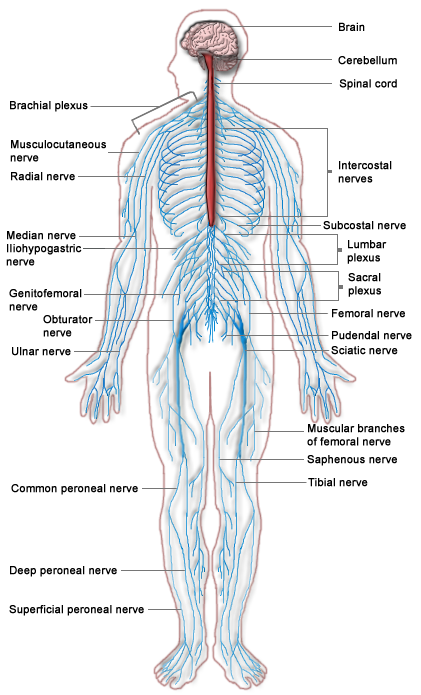11.8 Neurological System
The central nervous system consists of the brain, spinal cord, and other nerves in the body as seen in Figure 11.12.[1] The main function of the central nervous system is to utilize the senses of sight, touch, hearing, taste, and smell to detect changes in the external environment and create a reaction to them. For instance, if your finger comes into contact with a thorn on a rose bush, a sensory neuron transmits a signal from your finger up through the spinal cord and into the brain. Another neuron in the brain sends a signal that travels back to the muscles in your hand and stimulates muscles to contract so that you jerk your finger away. All this happens within a tenth of a second. Nerves communicate with each other via chemicals built from amino acids called neurotransmitters. Eating adequate protein from a variety of sources will ensure the body gets all the different amino acids that are important for central nervous system function.[2]

The brain’s cognitive functions include language processing, learning, perceiving, and thinking. The brain’s main fuel for these functions is glucose. Too high or too low levels of blood glucose can cause sudden changes in cognitive functioning, and chronically elevated blood-glucose levels can damage brain cells as previously discussed in the “Endocrine System” section of this chapter.
As people age, the transmission of neurons slows, causing slower reactions to environmental stimuli. This longer reaction time can increase their risk for falls and other safety concerns. Functioning of the senses also declines, as previously discussed in section Chapter 9.7, “Assisting With Sensory Deficits.” Nursing assistants can assist with this general decline and improve safety by ensuring residents have their glasses, hearing aids, and other adaptive aids in place. Healthy nutritional choices such as foods rich in omega-3 fatty acids and antioxidants can be encouraged to keep the neurosensory system healthy, and activity can be promoted. Having conversations with residents and promoting social interaction whenever possible is one of the easiest ways to encourage word recall and stimulate thinking. Assisting residents to attend activity department offerings, such as board, card, and word games, or looking at memorabilia can help clients maintain their neurological health.[3]
Common conditions related to the neurosensory system include strokes, seizures, and dementia. Refer to section Chapter 3.2, “Emergency Situations” to review the appropriate responses for individuals suspected of having a stroke or seizure. Refer to section Chapter 10.5, “Caring for Clients With Dementia” to review interventions for individuals with dementia. See Table 11.8 regarding two common chronic conditions of the neurosensory system and related nursing assistant interventions. Keep in mind that a difficult aspect of these neurological diagnoses is knowing that symptoms will continue to worsen, so individuals with these diagnoses and their loved ones should be supported emotionally and monitored for signs of depression.
Table 11.8 Common Chronic Conditions of the Neurosensory System and Related Interventions[4],[5]
| Diagnosis | Definition | Symptoms to Report | Nursing Assistant Interventions |
|---|---|---|---|
| Parkinson’s Disease | Decreased production of dopamine that causes slowed movement, impaired coordination and balance, tremors, and speech difficulties. | Changes in strength, gait, mobility, or cognition. |
|
| Amyotrophic Lateral Sclerosis (ALS or Lou Gehrig’s Disease) | Decline in nerve cell function results in progressive muscle weakness. Loss of movement begins in extremities with eventual death from loss of function of respiratory muscles. | Increased difficulty breathing, swallowing, or speaking. |
|
- “Nervous system diagram.png ” by unknown is licensed under CC BY-NC-SA 3.0. Access for free at https://med.libretexts.org/Bookshelves/Nursing/Book%3A_Clinical_Procedures_for_Safer_Patient_Care_(Doyle_and_McCutcheon)/02%3A_Patient_Assessment/2.07%3A_Focused_Assessments ↵
- This work is a derivative of Human Nutrition by University of Hawai‘i at Mānoa Food Science and Human Nutrition Program and is licensed under CC BY NC SA 4.0 ↵
- This work is a derivative of Human Nutrition by University of Hawai‘i at Mānoa Food Science and Human Nutrition Program and is licensed under CC BY NC SA 4.0 ↵
- Mayo Clinic Staff. (2022, March 24). Parkinson’s disease. https://www.mayoclinic.org/diseases-conditions/parkinsons-disease/symptoms-causes/syc-20376055 ↵
- Mayo Clinic Staff. (2022, February 22). Amyotrophic lateral sclerosis (ALS). https://www.mayoclinic.org/diseases-conditions/amyotrophic-lateral-sclerosis/symptoms-causes/syc-20354022 ↵
Chemicals in the body used for nerve communication.

